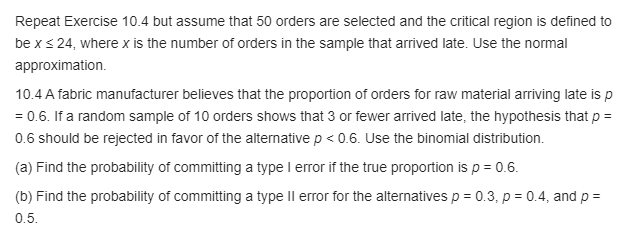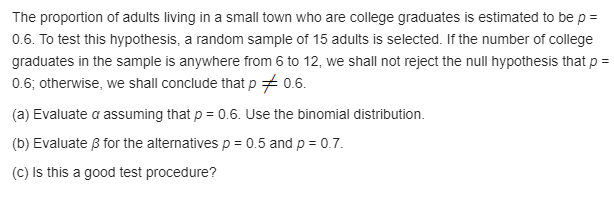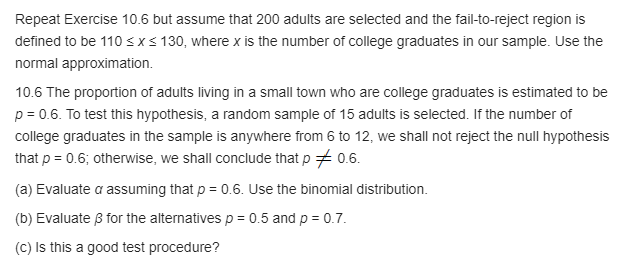refer to the attachments
80
Repeat Exercise 1&4 but assume that t] orders are selected and the critical region is dened to be it s 24, where x is the number of orders in the sample that arrived late. Use the normal approximation. 1(14 A fabric manufacturer believes that the proportion of orders for raw material arriving late is p = 13.6. If a random sample of 10 orders shows that 3 or fewer arrived late, the hypothesis that p = {1.6 should be rejected in favor of the altemative p -=: [15. Use the binomial distribution. {3} Find the probability.r of committing a type I error if the the proportion is p = [15. {b} Find the probability of committing a type II emor for tlte alternatives p = [1.3, p = n.4, and p = os. The proportion of adults living in a small town who are college graduates is estimated to be p = {16. To test this hypothesis, a random sample of 15 adults is selected. If the number of oollege graduates in the sample is anvwhere from E to 12, we shall not reject the null hypothesis that p = {16; otherwise, we shall conclude that p 75 [1.6. {a} Evaluate o assuming that p = US. Use the binomial distribution. to} Evaluate 18 for the altemaljves p = {1.5 and p = (1?. {o} Is this a good test procedure? Re peat Exercise 10.6 but assume that 200 adults are selected and the Tailtoreject region is dened to be 110 s I s 130. where x is the number of college graduates in our sample. Use the normal approximation. ll-:- The proportion of adults living in a small town who are college graduates is estimated to be p = [15. To test this hypothesis. a random sample of 15 adults is selected. If the number of college graduates in the sample is anywhere from E to 12, we shall not reject the null hypothesis that p = {1.6; othennlise, we shall conclude that p % 0.6. {a} Evaluate e assuming that p = us. Use the binomial distribution. {h} Evaluate p for the alternatives p = as and p = o.?. {c} Is this a good test procedure? In Relief frbm Arthritis published by Thorsons Publishers, Ltd., John E. Crolt claims that over 40% of those who suffer from osteoarthritis receive measurable relief from an ingredient produced bv a particular species of mussel found off the coast of New Zealand. To test this claim, the mussel extract is to be given to a group of i" osteoarthritic patients. If 3 or more ofthe patients receive relief, we shall not reject the null hypothesis that p = [14; otherwise, we conclude that p a: o4. {a} Evaluate o, assuming that p = {14. {b} Evaluate 18 for the alternative p = [13. A drv cleaning establishment claims that a nevir spot remover will remove more than Tots ofthe spots to which it is applied. To check this claim, the spot removerwill be used on 12 spots chosen at random. If fewer than 11 of the spots are removed, we shall not reject the null hypothesis that p = (1?; othenvise, we conclude that p :- [i]. {a} Evaluate o, assuming that p = (1?. {h} Evaluate t for the altemaljve p = (19. Repeat Exercise 10.9 but assume that 1oo spots are treated and the critical region is dened to he x :=- 32, where x is the number of spots removed. 10.9 i'itdriir cleaning establishment claims that a new spot remover will remove more than TFG'K: of the spots to which it is applied. To check; this claim, the spot remover will he used on 12 spots chosen at random. If fewer than 11 of the spots are removed, we shall not reject the null hypothesis that p = (1?; otherwise, we conclude that p :-~ [l]. {a} Evaluate o, assuming that p = (1?. in} Evaluate p for the altemaijve p = as. Repeat Exercise 1D_8 but assume that It'd patients are given the mussel extract and the critical region is dened to be x =: 24, where x is the number of osteoarthritic patients who receive relief. \"LB In Heller from Arthritis published by Thorsons Publishers, Ltd_, John E. Croft claims that over 40% of those who suffer fmm osteoarthritis receive measurable relief from an ingredient pmduced by a particular species of mussel found off the coast of New Zealand. To test this claim, the mussel extract is to be given to a group of Ir' osteoarthritic pahents. If 3 or more of the patients receive relief, we shall not reject the null hvpothesis that p = [14; otherwise, we conclude that p er. {14. {a} Evaluate o, assuming that p = (14. in} Evaluate p for the altemaljve p = as













